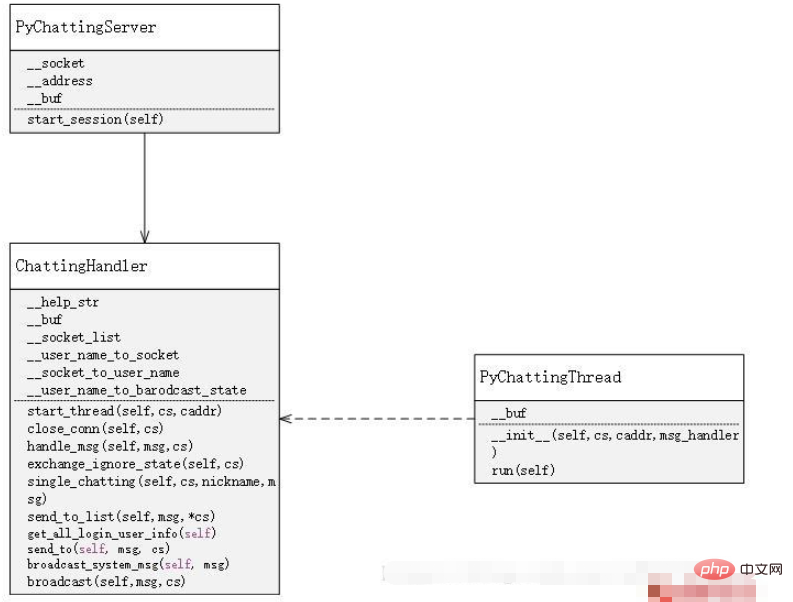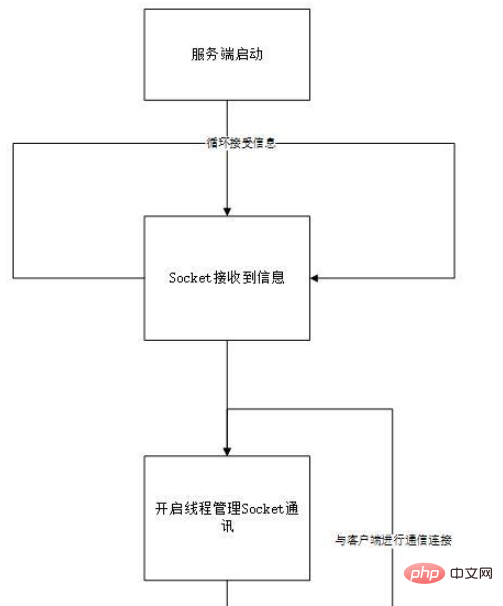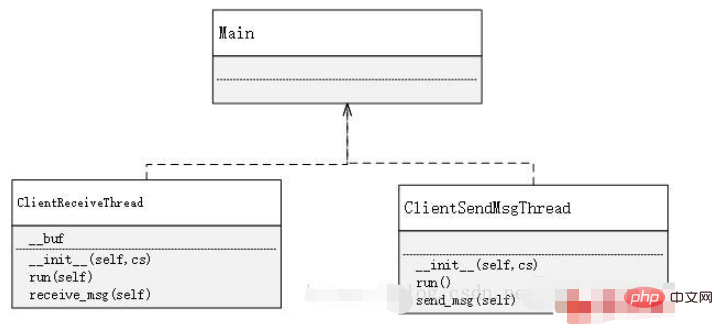Tutorial on writing a simple chat program in Python
Implementation ideas
x01 Establishment of the server
First, on the server side, use socket to accept messages. Every time a socket request is accepted, a socket is opened. A new thread is used to manage the distribution and acceptance of messages. At the same time, there is a handler to manage all threads, thereby realizing the processing of various functions of the chat room
x02 Establishment of the client
The establishment of the client is much simpler than the server. The function of the client is only to send and receive messages, and to enter specific characters according to specific rules to achieve the use of different functions. Therefore, in On the client side, you only need to use two threads, one is dedicated to receiving messages, and the other is dedicated to sending messages. As for why not use one, that is because, if you only use one, then After receiving a message, the one that receives the message is in a blocked state before sending it. Similarly, the same is true for sending a message. If these two functions are implemented in one place, it will make it impossible to continuously send or receive messages.
Implementation method
Server-side implementation

import json
import threading
from socket import *
from time import ctime
class PyChattingServer:
__socket = socket(AF_INET, SOCK_STREAM, 0)
__address = ('', 12231)
__buf = 1024
def __init__(self):
self.__socket.bind(self.__address)
self.__socket.listen(20)
self.__msg_handler = ChattingHandler()
def start_session(self):
print('等待客户连接...\r\n')
try:
while True:
cs, caddr = self.__socket.accept()
# 利用handler来管理线程,实现线程之间的socket的相互通信
self.__msg_handler.start_thread(cs, caddr)
except socket.error:
pass
class ChattingThread(threading.Thread):
__buf = 1024
def __init__(self, cs, caddr, msg_handler):
super(ChattingThread, self).__init__()
self.__cs = cs
self.__caddr = caddr
self.__msg_handler = msg_handler
# 使用多线程管理会话
def run(self):
try:
print('...连接来自于:', self.__caddr)
data = '欢迎你到来PY_CHATTING!请输入你的很cooooool的昵称(不能带有空格哟`)\r\n'
self.__cs.sendall(bytes(data, 'utf-8'))
while True:
data = self.__cs.recv(self.__buf).decode('utf-8')
if not data:
break
self.__msg_handler.handle_msg(data, self.__cs)
print(data)
except socket.error as e:
print(e.args)
pass
finally:
self.__msg_handler.close_conn(self.__cs)
self.__cs.close()
class ChattingHandler:
__help_str = "[ SYSTEM ]\r\n" \
"输入/ls,即可获得所有登陆用户信息\r\n" \
"输入/h,即可获得帮助\r\n" \
"输入@用户名 (注意用户名后面的空格)+消息,即可发动单聊\r\n" \
"输入/i,即可屏蔽群聊信息\r\n" \
"再次输入/i,即可取消屏蔽\r\n" \
"所有首字符为/的信息都不会发送出去"
__buf = 1024
__socket_list = []
__user_name_to_socket = {}
__socket_to_user_name = {}
__user_name_to_broadcast_state = {}
def start_thread(self, cs, caddr):
self.__socket_list.append(cs)
chat_thread = ChattingThread(cs, caddr, self)
chat_thread.start()
def close_conn(self, cs):
if cs not in self.__socket_list:
return
# 去除socket的记录
nickname = "SOMEONE"
if cs in self.__socket_list:
self.__socket_list.remove(cs)
# 去除socket与username之间的映射关系
if cs in self.__socket_to_user_name:
nickname = self.__socket_to_user_name[cs]
self.__user_name_to_socket.pop(self.__socket_to_user_name[cs])
self.__socket_to_user_name.pop(cs)
self.__user_name_to_broadcast_state.pop(nickname)
nickname += " "
# 广播某玩家退出聊天室
self.broadcast_system_msg(nickname + "离开了PY_CHATTING")
# 管理用户输入的信息
def handle_msg(self, msg, cs):
js = json.loads(msg)
if js['type'] == "login":
if js['msg'] not in self.__user_name_to_socket:
if ' ' in js['msg']:
self.send_to(json.dumps({
'type': 'login',
'success': False,
'msg': '账号不能够带有空格'
}), cs)
else:
self.__user_name_to_socket[js['msg']] = cs
self.__socket_to_user_name[cs] = js['msg']
self.__user_name_to_broadcast_state[js['msg']] = True
self.send_to(json.dumps({
'type': 'login',
'success': True,
'msg': '昵称建立成功,输入/ls可查看所有在线的人,输入/help可以查看帮助(所有首字符为/的消息都不会发送)'
}), cs)
# 广播其他人,他已经进入聊天室
self.broadcast_system_msg(js['msg'] + "已经进入了聊天室")
else:
self.send_to(json.dumps({
'type': 'login',
'success': False,
'msg': '账号已存在'
}), cs)
# 若玩家处于屏蔽模式,则无法发送群聊消息
elif js['type'] == "broadcast":
if self.__user_name_to_broadcast_state[self.__socket_to_user_name[cs]]:
self.broadcast(js['msg'], cs)
else:
self.send_to(json.dumps({
'type': 'broadcast',
'msg': '屏蔽模式下无法发送群聊信息'
}), cs)
elif js['type'] == "ls":
self.send_to(json.dumps({
'type': 'ls',
'msg': self.get_all_login_user_info()
}), cs)
elif js['type'] == "help":
self.send_to(json.dumps({
'type': 'help',
'msg': self.__help_str
}), cs)
elif js['type'] == "sendto":
self.single_chatting(cs, js['nickname'], js['msg'])
elif js['type'] == "ignore":
self.exchange_ignore_state(cs)
def exchange_ignore_state(self, cs):
if cs in self.__socket_to_user_name:
state = self.__user_name_to_broadcast_state[self.__socket_to_user_name[cs]]
if state:
state = False
else:
state = True
self.__user_name_to_broadcast_state.pop(self.__socket_to_user_name[cs])
self.__user_name_to_broadcast_state[self.__socket_to_user_name[cs]] = state
if self.__user_name_to_broadcast_state[self.__socket_to_user_name[cs]]:
msg = "通常模式"
else:
msg = "屏蔽模式"
self.send_to(json.dumps({
'type': 'ignore',
'success': True,
'msg': '[TIME : %s]\r\n[ SYSTEM ] : %s\r\n' % (ctime(), "模式切换成功,现在是" + msg)
}), cs)
else:
self.send_to({
'type': 'ignore',
'success': False,
'msg': '切换失败'
}, cs)
def single_chatting(self, cs, nickname, msg):
if nickname in self.__user_name_to_socket:
msg = '[TIME : %s]\r\n[ %s CHATTING TO %s ] : %s\r\n' % (
ctime(), self.__socket_to_user_name[cs], nickname, msg)
self.send_to_list(json.dumps({
'type': 'single',
'msg': msg
}), self.__user_name_to_socket[nickname], cs)
else:
self.send_to(json.dumps({
'type': 'single',
'msg': '该用户不存在'
}), cs)
print(nickname)
def send_to_list(self, msg, *cs):
for i in range(len(cs)):
self.send_to(msg, cs[i])
def get_all_login_user_info(self):
login_list = "[ SYSTEM ] ALIVE USER : \r\n"
for key in self.__socket_to_user_name:
login_list += self.__socket_to_user_name[key] + ",\r\n"
return login_list
def send_to(self, msg, cs):
if cs not in self.__socket_list:
self.__socket_list.append(cs)
cs.sendall(bytes(msg, 'utf-8'))
def broadcast_system_msg(self, msg):
data = '[TIME : %s]\r\n[ SYSTEM ] : %s\r\n' % (ctime(), msg)
js = json.dumps({
'type': 'system_msg',
'msg': data
})
# 屏蔽了群聊的玩家也可以获得系统的群发信息
for i in range(len(self.__socket_list)):
if self.__socket_list[i] in self.__socket_to_user_name:
self.__socket_list[i].sendall(bytes(js, 'utf-8'))
def broadcast(self, msg, cs):
data = '[TIME : %s]\r\n[%s] : %s\r\n' % (ctime(), self.__socket_to_user_name[cs], msg)
js = json.dumps({
'type': 'broadcast',
'msg': data
})
# 没有的登陆的玩家无法得知消息,屏蔽了群聊的玩家也没办法获取信息
for i in range(len(self.__socket_list)):
if self.__socket_list[i] in self.__socket_to_user_name \
and self.__user_name_to_broadcast_state[self.__socket_to_user_name[self.__socket_list[i]]]:
self.__socket_list[i].sendall(bytes(js, 'utf-8'))
def main():
server = PyChattingServer()
server.start_session()
main() Client-side implementation
Client-side implementation

import json
import threading
from socket import *
is_login = False
is_broadcast = True
class ClientReceiveThread(threading.Thread):
__buf = 1024
def __init__(self, cs):
super(ClientReceiveThread, self).__init__()
self.__cs = cs
def run(self):
self.receive_msg()
def receive_msg(self):
while True:
msg = self.__cs.recv(self.__buf).decode('utf-8')
if not msg:
break
js = json.loads(msg)
if js['type'] == "login":
if js['success']:
global is_login
is_login = True
print(js['msg'])
elif js['type'] == "ignore":
if js['success']:
global is_broadcast
if is_broadcast:
is_broadcast = False
else:
is_broadcast = True
print(js['msg'])
else:
if not is_broadcast:
print("[现在处于屏蔽模式]")
print(js['msg'])
class ClientSendMsgThread(threading.Thread):
def __init__(self, cs):
super(ClientSendMsgThread, self).__init__()
self.__cs = cs
def run(self):
self.send_msg()
# 根据不同的输入格式来进行不同的聊天方式
def send_msg(self):
while True:
js = None
msg = input()
if not is_login:
js = json.dumps({
'type': 'login',
'msg': msg
})
elif msg[0] == "@":
data = msg.split(' ')
if not data:
print("请重新输入")
break
nickname = data[0]
nickname = nickname.strip("@")
if len(data) == 1:
data.append(" ")
js = json.dumps({
'type': 'sendto',
'nickname': nickname,
'msg': data[1]
})
elif msg == "/help":
js = json.dumps({
'type': 'help',
'msg': None
})
elif msg == "/ls":
js = json.dumps({
'type': 'ls',
'msg': None
})
elif msg == "/i":
js = json.dumps({
'type': 'ignore',
'msg': None
})
else:
if msg[0] != '/':
js = json.dumps({
'type': 'broadcast',
'msg': msg
})
if js is not None:
self.__cs.sendall(bytes(js, 'utf-8'))
def main():
buf = 1024
# 改变这个的地址,变成服务器的地址,那么只要部署到服务器上就可以全网使用了
address = ("127.0.0.1", 12231)
cs = socket(AF_INET, SOCK_STREAM, 0)
cs.connect(address)
data = cs.recv(buf).decode("utf-8")
if data:
print(data)
receive_thread = ClientReceiveThread(cs)
receive_thread.start()
send_thread = ClientSendMsgThread(cs)
send_thread.start()
while True:
pass
main()The above is the detailed content of Tutorial on writing a simple chat program in Python. For more information, please follow other related articles on the PHP Chinese website!

Hot AI Tools

Undresser.AI Undress
AI-powered app for creating realistic nude photos

AI Clothes Remover
Online AI tool for removing clothes from photos.

Undress AI Tool
Undress images for free

Clothoff.io
AI clothes remover

Video Face Swap
Swap faces in any video effortlessly with our completely free AI face swap tool!

Hot Article

Hot Tools

Notepad++7.3.1
Easy-to-use and free code editor

SublimeText3 Chinese version
Chinese version, very easy to use

Zend Studio 13.0.1
Powerful PHP integrated development environment

Dreamweaver CS6
Visual web development tools

SublimeText3 Mac version
God-level code editing software (SublimeText3)

Hot Topics
 1655
1655
 14
14
 1413
1413
 52
52
 1306
1306
 25
25
 1252
1252
 29
29
 1226
1226
 24
24
 PHP and Python: Different Paradigms Explained
Apr 18, 2025 am 12:26 AM
PHP and Python: Different Paradigms Explained
Apr 18, 2025 am 12:26 AM
PHP is mainly procedural programming, but also supports object-oriented programming (OOP); Python supports a variety of paradigms, including OOP, functional and procedural programming. PHP is suitable for web development, and Python is suitable for a variety of applications such as data analysis and machine learning.
 Choosing Between PHP and Python: A Guide
Apr 18, 2025 am 12:24 AM
Choosing Between PHP and Python: A Guide
Apr 18, 2025 am 12:24 AM
PHP is suitable for web development and rapid prototyping, and Python is suitable for data science and machine learning. 1.PHP is used for dynamic web development, with simple syntax and suitable for rapid development. 2. Python has concise syntax, is suitable for multiple fields, and has a strong library ecosystem.
 PHP and Python: A Deep Dive into Their History
Apr 18, 2025 am 12:25 AM
PHP and Python: A Deep Dive into Their History
Apr 18, 2025 am 12:25 AM
PHP originated in 1994 and was developed by RasmusLerdorf. It was originally used to track website visitors and gradually evolved into a server-side scripting language and was widely used in web development. Python was developed by Guidovan Rossum in the late 1980s and was first released in 1991. It emphasizes code readability and simplicity, and is suitable for scientific computing, data analysis and other fields.
 Python vs. JavaScript: The Learning Curve and Ease of Use
Apr 16, 2025 am 12:12 AM
Python vs. JavaScript: The Learning Curve and Ease of Use
Apr 16, 2025 am 12:12 AM
Python is more suitable for beginners, with a smooth learning curve and concise syntax; JavaScript is suitable for front-end development, with a steep learning curve and flexible syntax. 1. Python syntax is intuitive and suitable for data science and back-end development. 2. JavaScript is flexible and widely used in front-end and server-side programming.
 How to run sublime code python
Apr 16, 2025 am 08:48 AM
How to run sublime code python
Apr 16, 2025 am 08:48 AM
To run Python code in Sublime Text, you need to install the Python plug-in first, then create a .py file and write the code, and finally press Ctrl B to run the code, and the output will be displayed in the console.
 Where to write code in vscode
Apr 15, 2025 pm 09:54 PM
Where to write code in vscode
Apr 15, 2025 pm 09:54 PM
Writing code in Visual Studio Code (VSCode) is simple and easy to use. Just install VSCode, create a project, select a language, create a file, write code, save and run it. The advantages of VSCode include cross-platform, free and open source, powerful features, rich extensions, and lightweight and fast.
 Can vs code run in Windows 8
Apr 15, 2025 pm 07:24 PM
Can vs code run in Windows 8
Apr 15, 2025 pm 07:24 PM
VS Code can run on Windows 8, but the experience may not be great. First make sure the system has been updated to the latest patch, then download the VS Code installation package that matches the system architecture and install it as prompted. After installation, be aware that some extensions may be incompatible with Windows 8 and need to look for alternative extensions or use newer Windows systems in a virtual machine. Install the necessary extensions to check whether they work properly. Although VS Code is feasible on Windows 8, it is recommended to upgrade to a newer Windows system for a better development experience and security.
 How to run python with notepad
Apr 16, 2025 pm 07:33 PM
How to run python with notepad
Apr 16, 2025 pm 07:33 PM
Running Python code in Notepad requires the Python executable and NppExec plug-in to be installed. After installing Python and adding PATH to it, configure the command "python" and the parameter "{CURRENT_DIRECTORY}{FILE_NAME}" in the NppExec plug-in to run Python code in Notepad through the shortcut key "F6".




